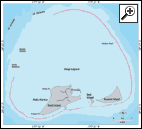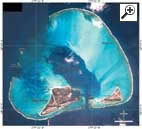
Midway Atoll
(Pihemanu)
Midway, the best known of the Northwestern Hawaiian Islands (NWHI), is a circular-shaped atoll with three small islets (Sand, Eastern, and Spit) on the southern end of a lagoon. While its land area is small, about 1,535 acres, the atoll has approximately 85,929 acres of reef area.
 Captain N.C. Brooks of the Gambia sailed to the atoll in 1859. After Brooks, the United States annexed it as the first insular possession to be claimed outside the U.S. continent. Early visitors included the castaway crews of several large sailing vessels, such as the American-built bark Carrollton. Survivors built low huts on the treeless island and awaited rescue by (infrequent) passing vessels. Other people made their way to Midway during the late 1800's promarily to collect feathers and eggs.
Captain N.C. Brooks of the Gambia sailed to the atoll in 1859. After Brooks, the United States annexed it as the first insular possession to be claimed outside the U.S. continent. Early visitors included the castaway crews of several large sailing vessels, such as the American-built bark Carrollton. Survivors built low huts on the treeless island and awaited rescue by (infrequent) passing vessels. Other people made their way to Midway during the late 1800's promarily to collect feathers and eggs.
The United States recognized the strategic importance of Midway as early as 1870, when efforts were begun to clear a southern channel into the calm lagoon. It was clear that Midway’s geographical position as a “stepping tone across the Pacific” made the island a critical link in cable communications (1903) and as an early transpacific Panamerican seaplane stop (1935). Work began on the military facility at Midway in March 1940.
 During World War II, Midway served as an important naval air station and submarine refit base. The atoll was attacked twice, first on December 7th 1941, and again during the pivotal Battle of Midway, June 4th-6th 1942. A successful American intelligence operation tipped the US forces to the planned attack, and a small US task force was able to surprise and defeat the Japanese invasion fleet bound for the atoll. Many interpret this battle as the watershed moment in the tide of the Pacific War. Though the major carrier-based actions took place to the north, a fierce air battle was waged over Midway and Eastern Islands themselves. The atoll was designated as the National Memorial to the Battle of Midway in 2000.
During World War II, Midway served as an important naval air station and submarine refit base. The atoll was attacked twice, first on December 7th 1941, and again during the pivotal Battle of Midway, June 4th-6th 1942. A successful American intelligence operation tipped the US forces to the planned attack, and a small US task force was able to surprise and defeat the Japanese invasion fleet bound for the atoll. Many interpret this battle as the watershed moment in the tide of the Pacific War. Though the major carrier-based actions took place to the north, a fierce air battle was waged over Midway and Eastern Islands themselves. The atoll was designated as the National Memorial to the Battle of Midway in 2000.
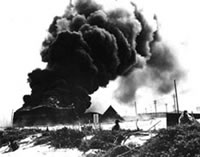 During the Cold War era, Midway served as the staging point for defensive air patrols along the Distant Early Warning (DEW) Line. With the increasing use of satellite observation, such patrols became unnecessary, and in 1996 the once strategic naval base was turned over to the U.S. Fish and Wildlife Service to be managed as Midway Atoll National Wildlife Refuge. A massive U.S. Navy clean up prior to their departure removed tons of debris, leaky fuel tanks, and lead paint, as well as rats. Today a fulltime Refuge staff administers a small visitor program, cares for its wildlife, restores native plant life, and protects historic resources. The wreck of the Macaw, a 250-foot submarine rescue vessel lost in 1944, marks the site of one such historic wartime event in Midway's waters.
During the Cold War era, Midway served as the staging point for defensive air patrols along the Distant Early Warning (DEW) Line. With the increasing use of satellite observation, such patrols became unnecessary, and in 1996 the once strategic naval base was turned over to the U.S. Fish and Wildlife Service to be managed as Midway Atoll National Wildlife Refuge. A massive U.S. Navy clean up prior to their departure removed tons of debris, leaky fuel tanks, and lead paint, as well as rats. Today a fulltime Refuge staff administers a small visitor program, cares for its wildlife, restores native plant life, and protects historic resources. The wreck of the Macaw, a 250-foot submarine rescue vessel lost in 1944, marks the site of one such historic wartime event in Midway's waters.
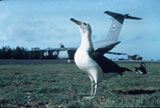 Nearly two million birds of 19 species nest on Midway. The atoll has the largest Laysan albatross colony in the world. Other birds include black-footed albatross, red-tailed tropicbirds, white terns, black and brown noddies, shearwaters, and Bonin petrels. One of the rarest visitors is the endangered short-tailed albatross.
Nearly two million birds of 19 species nest on Midway. The atoll has the largest Laysan albatross colony in the world. Other birds include black-footed albatross, red-tailed tropicbirds, white terns, black and brown noddies, shearwaters, and Bonin petrels. One of the rarest visitors is the endangered short-tailed albatross.
Three-fourths of Midway's plant species were introductions. These include weeds, ornamental shrubs, exotic vegetables, and trees such as coconut palms and ironwood. Major efforts are underway to control alien species and restore native habitats.
The waters abound with dolphins, monk seals, and green sea turtles. More than 250 species of fish live in its waters, including hapu`upu`u (the Hawaiian grouper usually caught at depths exceeding 150 ft in the MHI, but often seen at diving depths at Midway), ulua (jack), kumu (goatfish), and sharks. Beyond the reefs are pelagic fishes such as tuna and marlin.
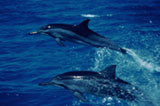 Despite 100 years of human impact, the reef at Midway is rich and diverse. Sixteen species of stony coral have been reported, and scientists believe there may be many more. Marine habitats, including spurs, grooves, and sand channels, are home to several algaes, seagrass meadows, urchins, bi-valve clams, sponges and more. Two species of seagrasses are found at Midway, one of which is a Hawaiian endemic, and the second species is one not previously recorded from the Hawaiian Islands.
Despite 100 years of human impact, the reef at Midway is rich and diverse. Sixteen species of stony coral have been reported, and scientists believe there may be many more. Marine habitats, including spurs, grooves, and sand channels, are home to several algaes, seagrass meadows, urchins, bi-valve clams, sponges and more. Two species of seagrasses are found at Midway, one of which is a Hawaiian endemic, and the second species is one not previously recorded from the Hawaiian Islands.
